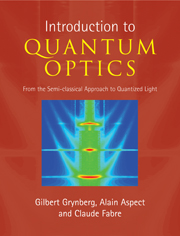Book contents
- Frontmatter
- Contents
- Foreword
- Preface
- Acknowledgements
- Part I Semi-classical description of matterlight interaction
- 1 The evolution of interacting quantum systems
- Complement 1A: A continuum of variable width
- Complement 1B: Transition induced by a random broadband perturbation
- 2 The semi-classical approach: atoms interacting with a classical electromagnetic field
- Complement 2A: Classical model of the atom-field interaction: the Lorentz model
- Complement 2B: Selection rules for electric dipole transitions. Applications to resonance fluorescence and optical pumping
- Complement 2C: The density matrix and the optical Bloch equations
- Complement 2D: Manipulation of atomic coherences
- Complement 2E: The photoelectric effect
- 3 Principles of lasers
- Complement 3A: The resonant Fabry–Perot cavity
- Complement 3B: The transverse modes of a laser: Gaussian beams
- Complement 3C: Laser light and incoherent light: energy density and number of photons per mode
- Complement 3D: The spectral width of a laser: the Schawlow–Townes limit
- Complement 3E: The laser as energy source
- Complement 3F: The laser as source of coherent light
- Complement 3G: Nonlinear spectroscopy
- Part II Quantum description of light and its interaction with matter
- Part III Applying both approaches
- Index
2 - The semi-classical approach: atoms interacting with a classical electromagnetic field
Published online by Cambridge University Press: 05 August 2012
- Frontmatter
- Contents
- Foreword
- Preface
- Acknowledgements
- Part I Semi-classical description of matterlight interaction
- 1 The evolution of interacting quantum systems
- Complement 1A: A continuum of variable width
- Complement 1B: Transition induced by a random broadband perturbation
- 2 The semi-classical approach: atoms interacting with a classical electromagnetic field
- Complement 2A: Classical model of the atom-field interaction: the Lorentz model
- Complement 2B: Selection rules for electric dipole transitions. Applications to resonance fluorescence and optical pumping
- Complement 2C: The density matrix and the optical Bloch equations
- Complement 2D: Manipulation of atomic coherences
- Complement 2E: The photoelectric effect
- 3 Principles of lasers
- Complement 3A: The resonant Fabry–Perot cavity
- Complement 3B: The transverse modes of a laser: Gaussian beams
- Complement 3C: Laser light and incoherent light: energy density and number of photons per mode
- Complement 3D: The spectral width of a laser: the Schawlow–Townes limit
- Complement 3E: The laser as energy source
- Complement 3F: The laser as source of coherent light
- Complement 3G: Nonlinear spectroscopy
- Part II Quantum description of light and its interaction with matter
- Part III Applying both approaches
- Index
Summary
We investigate in this chapter the general problem of the interaction of an atom (or a molecule) and a classical electromagnetic field. Its importance derives firstly from the fact that a large part of our knowledge of atoms is obtained from a study of the radiation they absorb or emit (we shall consider equally visible radiation and radio-frequency and X-rays) and, secondly, that the interaction with matter modifies the propagation of the electromagnetic field itself, notably through absorption, refraction or scattering. The interactions of atoms with light therefore encompass a vast range of physical effects that we could not hope to cover adequately in a single chapter. In this chapter we shall therefore present the fundamental features of the interaction of an atom, which will be treated quantum mechanically, with a classical electromagnetic field, that is an electromagnetic field described by real electric and magnetic vectors obeying Maxwell's equations.
A rigorous description of the atom–light interaction would have to take into account the quantum nature of light. This we shall leave to Chapter 6. It turns out, nevertheless, that many important results can be obtained from the semi-classical viewpoint adopted here (although it is perhaps more appropriate to refer to this treatment as ‘semi-quantized’).
- Type
- Chapter
- Information
- Introduction to Quantum OpticsFrom the Semi-classical Approach to Quantized Light, pp. 45 - 104Publisher: Cambridge University PressPrint publication year: 2010



